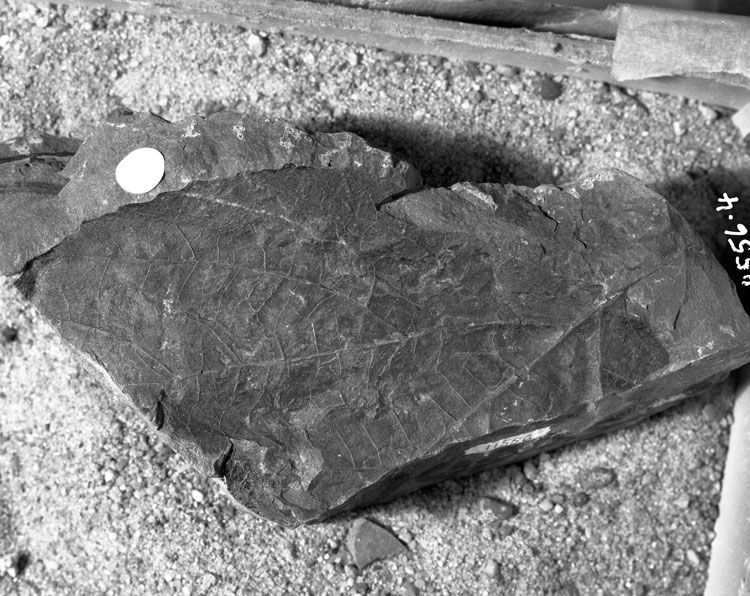Locality
Yukon-Koyukuk Basin Locality 11556
Description
Leaf: simple; symmetrical (?); very wide obovate (?); weakly trilobed; apex missing, apices of lobes obtuse; base rounded or truncate; margin serrate-dentate except at base where entire; teeth with obtuse angular apices, concave sides, shallow rounded sinuses, tooth apex glandular; primary midvein moderate, straight or nearly so; pectinal veins almost basilar, weaker than midvein, straight, diverging from midvein at approximately 45°, craspedodromous terminating in the apex of a lobe, projecting slightly beyond the lamina with a slight depression at the tip, nipple-like, branching admedially one or two times near the margin, admedial branches curved moderate to weak, craspedodromous; abmedial branches moderate to weak, departing pectinal at 45° at base, may increase to approximately 70° near lobe apex, straight to curved, weakly semicraspedodromous near base becoming craspedodromous near lobe apex; superior secondaries arising at approximately 40o from the midvein sometimes initially curved, straight, parallel, diverging slightly from pectinals, may be ad- and abmedially branched, curved, weak, craspedodromous; inferior secondaries very weak, one (?) pair, initially recurved then straight, oriented approximately at right angles to midvein; tertiary veins moderate, percurrent, often forked and coalescing to form weak intersecondary and inter-abmedial veins; joining ad- and abmedial sides of secondaries at acute or right angles, convex; fourth order veins moderate, orthogonal, percurrent; fifth order veins random to orthogonal reticulate.
Remarks
Specimens USGS 11556.84, USGS 11556.12, and USGS 11556.4 have been grouped together with specimen USGS 11556.13 under the Form HAPLTL30 because there are no significant differences in the characters they display (although they are very incomplete), and therefore there is no justification for treating them separately. Specimens USGS 11556.84, USGS 11556.12, and USGS 11556.4 all represent part of the basal margin including a pectinal vein and its abmedials. Fragmentation of a leaf in this manner is common and in fact Hollick described three such fragments as a separate form named Paracrednaria alaskana Hollick; Hollick apparently mistaking the pectinal vein for the midvein (Hollick 1930, p. 30; Plate 54, Figs. 1-3). Hollick's specimens differ from those described here, as well as from each other and are not considered as representing this particular form. One of Hollick's forms which is somewhat similar, however, is Populites platanoides (Hollick, 1930, p. 65; Plate 34, Fig. 5; Plate 36, Fig. 3). Neither of Hollick's specimens is complete enough to exhibit lobing but the base morphology and architecture are very similar. Interestingly Hollick compares his specimens to 'Platanus' wardii Knowlton (1900, p. 4; Plate 12, Figs. 1-4) which Knowlton considered to be trilobed.
The teeth of all the specimens described here are Platanoid in type but there is some evidence in specimen USGS 11556.13 for a fimbrial vein. The margin is marked by a darkening of the specimen and some veinlets apparently run into this marginal 'thickening'. The details are obscure however. The teeth of Populites platanoides are slightly more sharply defined and more irregular than those in these specimens.
Since the Russian material has been studied in detail we now assign this specimen to Ettingshausenia.
